 The artichoke (Cynara cardunculus subsp. scolymus; syn.: Cynara scolymus) is a popular vegetable, especially in Mediterranean countries. And it is not only the Francophiles and Italophiles among us who regularly eat this special vegetable. In our region, it is usually on the menu as a pizza topping. But the artichoke is much more. Not only for culinary reasons but also due to its gardening possibilities, the artichoke belongs in the home garden. Even when it is not harvested, this plant species is convincing. So let us prove to you that there is more to the artichoke than a mere – and sometimes unintentional – green-grey spot on a pizza.
The artichoke (Cynara cardunculus subsp. scolymus; syn.: Cynara scolymus) is a popular vegetable, especially in Mediterranean countries. And it is not only the Francophiles and Italophiles among us who regularly eat this special vegetable. In our region, it is usually on the menu as a pizza topping. But the artichoke is much more. Not only for culinary reasons but also due to its gardening possibilities, the artichoke belongs in the home garden. Even when it is not harvested, this plant species is convincing. So let us prove to you that there is more to the artichoke than a mere – and sometimes unintentional – green-grey spot on a pizza.
Artichokes – a versatile vegetable
Basically, the genus 'Cynara' belongs to the sunflower family and the different thistle species also belong to the same family. The term “thistle” is not a proper name in botany, but only a name component in different species and genera. And this close relationship of the artichoke with the thistles is quite obvious.
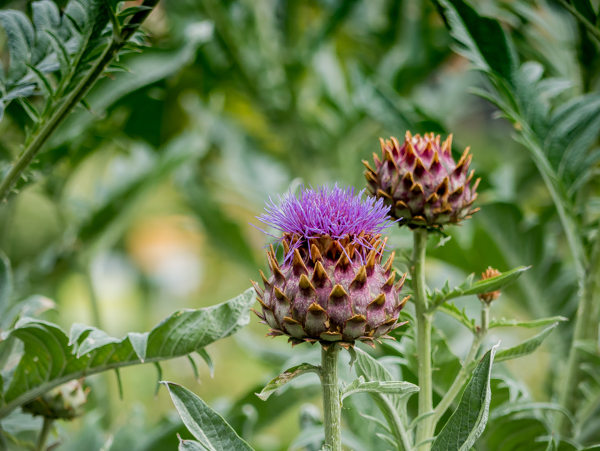
Picture: The close relationship of the artichoke to the thistle is well recognizable
The artichoke is essentially a perennial plant species. Artichoke plants form a basal leaf rosette with a height of 50 - 70 cm and they have a space requirement of about 1 m². From this rosette of leaves, depending on the variety, an up to 2 m tall stem with inflorescences forms already starting in the first year. If the closed flower buds are not harvested, then they develop into beautiful, violet-blue flowers that exhibit an extremely high ornamental value.
The origin of the artichoke
The original distribution area of the artichoke is the entire Mediterranean region: from Asia Minor to Persia, North Africa, Spain, and even the Canary Islands. And the artichoke has even made it into Greek mythology. According to this, Zeus had fallen in love with the nymph Cynara, but she rejected him. In his rage, Zeus then turned the nymph into the prickly artichoke. This story is still remembered by the botanical Latin name of the artichoke.
History and cultivation
The cultivation of artichokes in the Mediterranean area dates back to the 1st century AD and was then spread significantly by the Arabs, which is still reflected in the worldwide production figures. It was not until the 15th century that the artichoke cultivation came to Sicily, and from there it went to the United States along with Italian emigrants at the end of the 19th century. Today, Italy, Spain and France are the largest cultivating countries in Europe. Italy and Spain are also among the top three countries worldwide that cultivate artichokes. Among them, the five largest cultivating countries account for more than 70% of the total crop volume.
The largest artichoke producers worldwide (as of 2019):
| Ranking | Country | Production Amount (in tons) |
| 1 | Italy | 378,820 |
| 2 | Egypt | 296,899 |
| 3 | Spain | 199,940 |
| 4 | Peru | 131,882 |
| 5 | Algeria | 119,636 |
Other edible artichokes
The vegetable artichoke with its edible flower buds is not the only edible plant species or subspecies from the artichoke genus. In addition to the vegetable artichoke with its typical flower buds, there is another species of artichoke suitable for consumption, the cardoon (Cynara cardunculus), sometimes also called the artichoke thistle. With the cardoon, unlike the vegetable artichoke, the bleached and then cooked leaf stalks are eaten.
How are artichokes used in cooking?
Before the question of preparation is explained, it must first be clarified what is edible or rather, what is enjoyable at all in an artichoke fruit (the closed flower bud). If you take a closer look at the ratio between the weight of the entire artichoke fruit and the part that is eaten, you may be shocked.
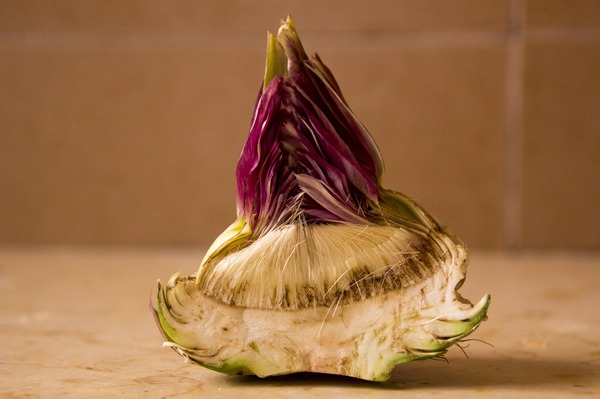
Picture: cut open artichoke fruit (flower bud), the bracts, the flower base and the hay in the middle are clearly visible
Only the lower, fleshy part of the scale-like bracts and the flower base are eaten – this is the part that is available in pickled form in retail stores and is also used as a pizza topping. The bulk of the total volume is the so-called 'choke', which is nothing more than the unopened flowers below the bracts. The largely inedible bracts also make up a large part of the unusable weight.

Picture: cooked Artichoke
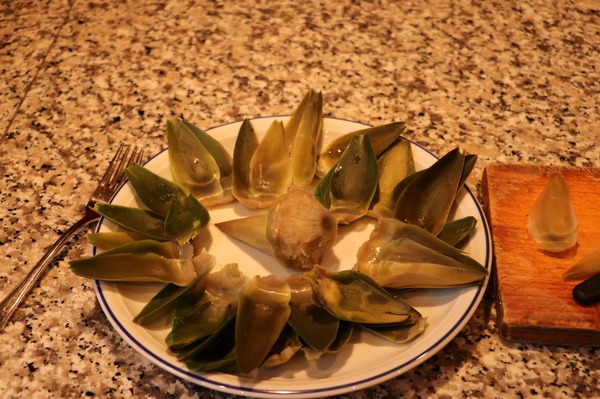
Picture: the individually peeled off bracts of the artichoke bud
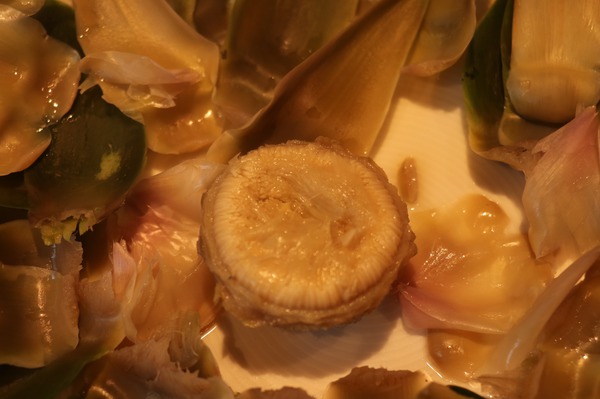
Picture: the flower base of the cooked artichoke
Preparation, on the other hand, is quite simple. To do this, boil the whole artichoke fruit in salted water for 20 to 45 minutes, to which a squeeze of lemon juice is added. The correct cooking time depends on the size of the artichokes. After cooking, the bracts are detached one by one and dipped in a suitable dip – and thus the enjoyment can begin. This is done by putting the bracts in the mouth and squeezing them between the teeth so that the soft flesh is scraped off and sucked out. Under the bracts, the inedible choke soon appears, this is carefully removed and so you finally get to the heart of the artichoke, the flower base.
Artichokes in the home garden – EverVeg® plants for gourmets
As already mentioned, the Mediterranean region is the original distribution area of the artichoke. Due to this fact it is not surprising that the artichoke is often described as heat-loving but also as frost-sensitive, both of which are – at least partially – true. Nevertheless, some varieties can also be grown well in Central Europe, north of the Alps. Here, it is not so much the winter frost as the winter precipitation that is problematic.
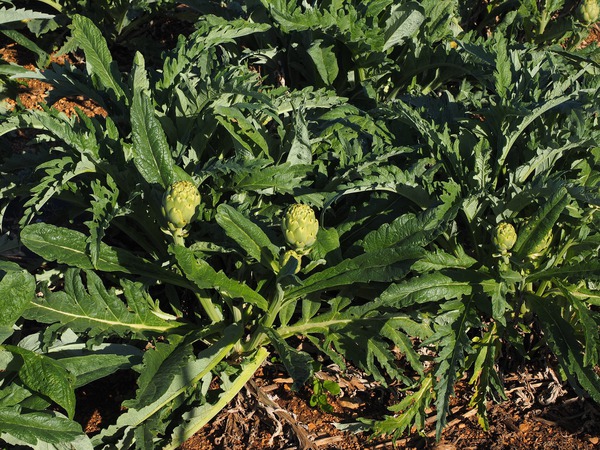
Picture: a well developed artichoke plant with fruits/flower buds ready for harvesting
The right location for artichokes
The preferable location for artichokes in the home garden should be a site that is as protected as possible with fairly permeable soil. In heavy clay soil, the nutrient-requiring artichokes also grow very well, but here the risk of plant failure increases during the winter. Additional winter protection of straw is quite reasonable, except for locations with a wine-growing climate. In order not to let the artichokes drown and rot in wet and cool soil during the winter, a slight mound planting is also possible – but then the cold protection with straw and brushwood should be done all the more carefully.
When to plant artichokes
Depending on the size of the planted artichoke and depending on the time of planting, a harvest can be expected as early as the year of planting. Our offered artichoke varieties are characterised by the fact that they produce fruits or flowers already in the first year. For this, however, an early plant production (potting at the end of March/beginning of April) is just as necessary as an early planting in the garden (beginning of June at the latest). However, artichokes can still be planted reliably until late summer. Then the plants form only the leaf rosette and then they will fruit or bloom all the better the following year.
Artichokes are completely unsuitable for growing in containers. Planted directly in the garden soil, the artichokes thrive much better and bring all the more yield. When planting, however, it is essential to ensure a sufficient planting distance of at least 1 m, since a strong-growing artichoke plant needs about 1 m² to develop ideally.
Artichokes as EverVeg® plants and as ornamental plants

Picture: the large violet-blue flowers give the artichokes a good added value towards the ornamental plant; however, to enjoy the flowers, you have to give up the culinary pleasure...
If you then provide the plants with appropriate winter protection, you can look forward to harvest-fresh artichokes from your own garden for years to come. However, one should not consistently harvest all of the artichokes, but rather leave one or two buds, thus allowing the artichoke plant to unfold the wonderful, violet-blue flowers. The flowers will then develop into real insect magnets in no time at all.
Artichoke young plants from Lubera Edibles
Like the other vegetable young plants from the EverVeg® assortment, our artichoke young plants are offered in our standard 60-cell young plant tray and are available in both organic and conventional quality. Due to our selection of varieties, even a young artichoke plant produced in the spring will – if ideally cultivated – produce the first flower buds for harvesting at the end customer in the summer.
Our artichoke young plants are available from the 12th calendar week and can be produced by you in several sets so that you can offer your customers an ideal sales product.

Picture: Artichoke young plants from Lubera Edibles
You have not ordered artichoke young plants yet? Then ask us about your requirements or order your artichoke young plants already now for the coming season.
The production of artichoke plants for retailers
We recommend that you produce artichoke plants as part of a larger vegetable range. For example, as part of the EverVeg® assortment or together with annual vegetable plants from our product group 'Fruits of the Roots®'. To be less comparable and to avoid direct competition with the mass market, we recommend that you rather produce and offer a larger vegetable plant (so certainly not a tray of 6 or 10). Thus, the pot you choose should be at least a 13 cm pot, but with our artichoke young plants, you can very well produce a C3 (3 litres) that will be filled within 6 to 8 weeks.
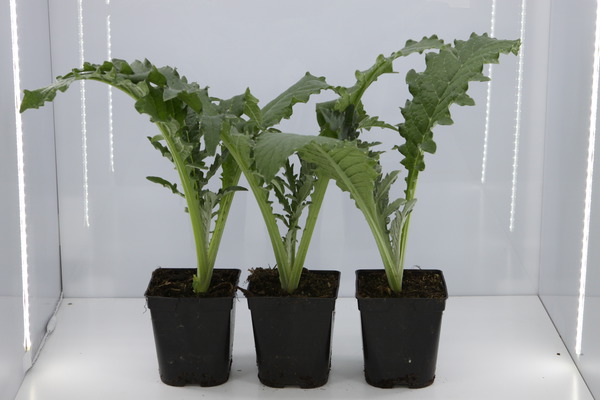
Picture: well developed and ready to sell artichoke plants in C1.3, here the artichoke variety 'Vert de Laon'
More artichoke articles!
If we have now sparked your interest in our artichoke young plants, then check out our other blog article on the subject of artichokes, in which we present our artichoke young plants assortment.
Artichoke young plants – the assortment at Lubera Edibles
You can find more blog articles on the topics of 'Vegetable Young Plants' and 'EverVeg® Plants' here:
